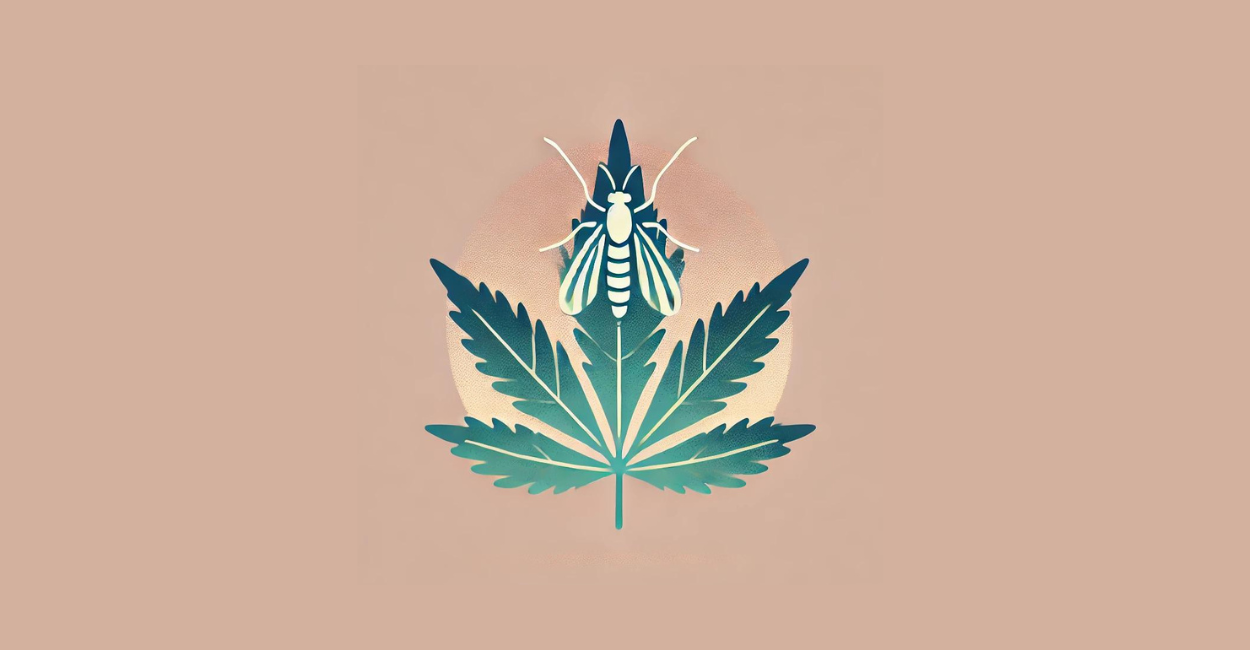In this article, we delve into the topic of "Thrips on Cannabis". Thrips, also known as fringe-winged insects, are small but potent pests that can cause significant damage to your cannabis plants. These tiny marauders may be small, but their impact is mighty, like a stealthy squadron silently sabotaging your grow operation. We will share our experiences dealing with these pests, describe the typical damage caused by thrips, and discuss effective control and preventive strategies to keep your plants thriving.
Identifying Thrips on Cannabis Plants
Thrips are small, tissue-penetrating insects that can significantly affect the growth and yield of cannabis plants. These pests cause growth disturbances and yield losses. Similar to aphids, they suck plant sap and leave damage on the leaves. From our extensive experience in cannabis cultivation, we have learned that early detection and treatment are crucial to keeping the plants healthy.
Signs of Infestation:
- Stunted Leaves: Thrips suck nutrients, minerals, and sugars from the leaves.
- Black Spots: Fecal deposits on leaves and stems.
Causes of Thrip Infestation
Several factors can lead to a thrip infestation:
- Improper pH levels: in the growing medium
- Poor soil drainage:
- Water hardness:
- Nutrient lockout: due to high EC (electrical conductivity) or ppm (parts per million) values
Thrips thrive in environments with high temperatures and low humidity. Poor air circulation and the presence of dust can also contribute to their proliferation. Based on our experiences, it is important to control these factors to prevent an infestation.
Prevention and Treatment of Thrip Infestation
Effective prevention and treatment methods include:
Environmental Control
Maintaining optimal environmental conditions is crucial to prevent thrip infestations. We have found that good temperature and humidity control significantly contribute to prevention.
- Temperature: Keep the temperature around 20°C.
- Humidity: Increase humidity if it is too low.
- Air Circulation: Use fans to improve air circulation.
Pruning and Cleaning
Regular pruning and cleaning can help reduce and control thrip populations. Our practice shows that removing affected parts effectively prevents the spread.
- Pruning: Cut off and dispose of infested areas to prevent the spread of thrips.
Spraying
Spraying plants can help effectively reduce thrip populations. A neem oil solution has proven particularly effective.
- Neem Oil Solution: Mix 1 tablespoon of neem oil with 4 liters of water, add a few drops of dish soap, stir thoroughly, and fill the solution into a spray bottle. This mixture helps repel and combat thrips.
Biological Insecticides and Soaps
Biological insecticides and soaps are effective for treating thrip infestations. In our opinion, these methods are the most effective, and with the right application, significant damage can be avoided, as we have found from experience.
- Essentria IC3: Apply daily. This product is effective for 8-12 hours.
- Spinosad: Spray directly onto plants or add to irrigation water for systemic treatment.
- NukeEm: Apply to plants to kill thrips at all stages of development.
- SM-90: Mix with water and spray onto plants. This product is known for its effectiveness against thrips.
- Insecticidal Soaps: Apply to infested areas. Avoid direct application on flowers to prevent residues.
Essential and Horticultural Oils
Essential and horticultural oils can be used to combat thrips. Our crew has found these oils to be particularly effective when applied regularly.
- Neem Oil, Eucalyptus Oil, Cinnamon Oil, Lemon Oil, Peppermint Oil, Rosemary Oil: Mix with water and spray onto plants. Avoid spraying on flowers to prevent residues.
- Horticultural Oils: Regularly apply oils such as canola oil, soybean oil, or cottonseed oil to treat plants.
Introducing Beneficial Insects
Introducing natural predators of thrips can help control their populations. In our experience, these biological methods are very effective and environmentally friendly.
- Ladybugs: Introduce as larvae or adult insects.
- Lacewings: Purchase lacewing eggs or larvae.
- Predatory Mites: Buy Amblyseius cucumeris in bags and release them according to product instructions.
- Rove Beetles: Provide mulch (a few centimeters of grass clippings or dead leaves) around the plants.
Important Note:
Effectively combating thrips on your cannabis plants is crucial for their health and productivity. If you notice signs of infestation such as stunted leaves or black spots, adjust your pest control measures. Introducing natural predators can help eliminate thrips. Always monitor the growing environment, as maintaining optimal conditions can prevent infestations. For more information on combating thrips, see our article on beneficial insects in cannabis cultivation against thrips.
Conclusion:
Thrip infestations can significantly affect the growth and yield of cannabis plants. Early detection, proper treatment, and preventive measures are essential. Our experience shows that a proactive approach and the use of effective pest control strategies ensure healthy, productive cannabis plants.
Disclaimer
This website's content is for informational use only and should not be considered medical or legal advice. Always consult a healthcare professional for health-related issues. Be aware of local regulations regarding cannabis cultivation. We are not liable for any actions taken based on this information.

